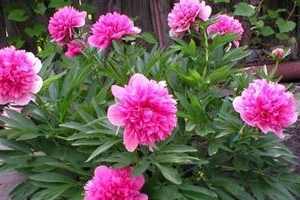
When to transplant peonies in the fall in what month. How to plant peonies in the summer
Or in May. Dig up the bush, trying to capture as much as possible larger piece soil on the roots. Prepare a hole in the area, preferably a small one. Add nutritious, loose soil there. At the same time, avoid adding fresh organics, it is better to use rotted compost, manure or a complete mineral fertilizer.
In summer, watch peonies especially carefully. Tear off the buds that appeared first after transplantation. And water the bushes daily.
If the plant does not take root well in a new place, choose another seat for them towards the end of summer.
The roots of the flower may break off when you dig up the bush for replanting, as they are very fragile in spring. Gather the cuts and pieces of the roots and plant them in a bed of loose, nutritious soil, so you will get additional bushes in the future.
Take charcoal, push it and process the sections of the broken roots. In August, you can carefully transplant them to another, more convenient bed, not forgetting to water regularly.
But it is best to transplant peonies in the fall. The place on the site where you will transfer the flower should be sunny and open. The proximity of groundwater is undesirable to prevent root rot.
Prepare a landing site 3-4 weeks before the start of work. Dig a hole, fill it 2/3 with a mixture of peat, humus, sand and garden soil taken in equal proportions. Add 220 g of double superphosphate, a jar of wood ash and a tablespoon of iron sulfate.
The rhizome of the peony is dug very carefully. Since the roots penetrate the ground to a depth of 0.5-1 meters, this will have to be done for a long time. Do not use a shovel, better take a pitchfork, and dig the rhizome in a circle, then pull it out of the ground, holding it with shovels on both sides. Leave the plant in the shade for 2-3 hours to avoid root brittleness.
Now you need to divide the peony to get a division and a part of the rhizome about 10-15 cm in size. Remove the small and rotted parts of the root. It is better to do this with a knife or a sharp wooden wedge. Start by dividing into 2-3 parts, and then smaller. Before planting, delenki can be placed in a container with a saturated solution of potassium permanganate to disinfect.
Plant a bush in ready pit, sprinkle on top with earth taken from the garden. Make sure that the layer is no more than 5 cm, and then water well. Remember that a young plant needs to be regularly looked after, constantly watered, loosened the soil, removed buds, weeded, sprayed from pests, etc. In the second year of life, peonies rarely bloom, delighting with an abundance of inflorescences after a few more seasons, in the summer.
In almost every household plot, in the garden there are flower beds with perennial flowers. One of the most popular flowering bushes is peonies. Although their flowering is short-lived, during this period they will be able to leave incredible emotions with the owners. In order for a perennial bush to grow well, it is required to transplant peonies in the fall to another place, once every 3-5 seasons. Thus, it will be possible to maintain the plant in a healthy state.
Peonies are beautiful plants that delight the eye and can easily grow and bloom in one place for more than half a century. However, when they are constantly in one place, they may have difficulties. The bush may stop blooming. In this case, you need to transplant the bush into the most suitable soil. This must be done in the autumn.
This is justified by the fact that the successful wintering of a plant depends on the state of its root system. If at the beginning of autumn, when the root system begins to accumulate all the nutrients in itself, the bush is transplanted, the likelihood that it will adapt to new conditions and begin to bloom in the spring is very high. In addition, it is easier for a plant to adapt in a new place in a cool time, the summer heat is well experienced by a plant that overwintered at the transplant site.
The bush will be taken in a well-lit, draft-protected place. With a lack of lighting, it may stop blooming. The flower loves the sun, but it cannot stand overheating. So the best place for bushes is away from fences and other objects that can give peonies their heat. If a gardener wants to transplant a bush into constantly moist soil, due to the proximity of water sources, then he will not only not wait for a flower, but will also see how the peony rots.
Therefore, if it so happened that the landing site is distinguished by the presence of groundwater, it is best to make a high bed - so the roots of the plant will not reach the destructive level.
Bush preparation
Before digging up a flower, you need to make sure that the place for planting is prepared. The pit is dug out quite large to place prepared soil mixed with humus, or bought in a store.
- Dig the bush carefully so as not to damage the roots too much.
- Do not touch the root system, that is, do not destroy the earthen ball that has formed around it.
- If it was not possible to save the lump, remove all old and damaged roots.
- Trim the green stems, leaving about 10 - 15 centimeters from the root zone. That is, only sticks without leaves should stick out.
After completing all the steps, you can start landing. There are no specific rules or restrictions. You can act the way you like. The bush is perfectly adapted to any growing conditions. Natural and climatic conditions do not affect its flowering and other life processes. Of course, one should not forget that decorative options perennial flower are more whimsical than simple ones.
How is the transplant done?
 It is recommended to start digging holes for transplanting peonies in the fall in the summer. Their diameter should be approximately eighty centimeters, depth - seventy. If it is necessary to transplant several bushes side by side, the pits should be made at a distance of more than a meter from each other.
It is recommended to start digging holes for transplanting peonies in the fall in the summer. Their diameter should be approximately eighty centimeters, depth - seventy. If it is necessary to transplant several bushes side by side, the pits should be made at a distance of more than a meter from each other.
Drainage must be laid in the finished pit. More than half of the hole (about two-thirds) must be filled with a soil mixture consisting of garden soil, humus and sand. It is necessary to fertilize the soil a little and mix it with drainage, then water it.
Before transplanting to another place, the prepared land should be compacted. Before and after planting, you need to carefully monitor the acidity of the soil. In the Kuban, transplanting peonies in the fall to another place is carried out in the same way as in other regions, you can watch videos of professional gardeners and see for yourself. Almost all flowers are unpretentious, especially if they are perennial.
- To transplant peonies, it is necessary to cut their stems almost to the ground.
- After the plant needs to be carefully dug up - it is recommended to carefully dig it from below, making a long trench.
- In order not to damage the root system of the plant, digging should be done, stepping back from the extreme stems of about thirty centimeters.
- For maximum convenience, it is recommended to get a cut peony with a pitchfork. Do not pull the plant out of the ground by the stems - this can damage its roots and buds, which are located at its base and begin to develop for many years to come.
Having taken the bush out of the ground, it is necessary to free its roots from excess earth with a shovel. Next, the peony needs to be put in a shady place for a couple of hours - during this time its roots will no longer be too brittle - and this is very important when transplanting.
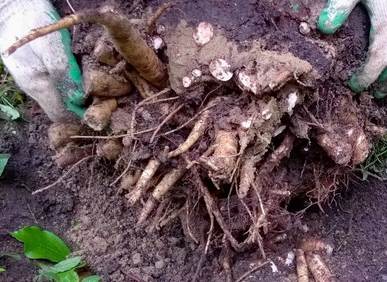
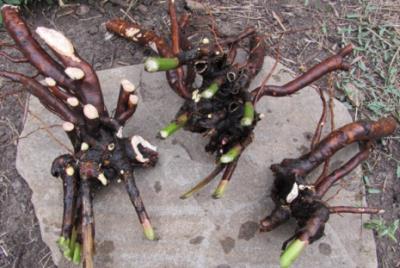
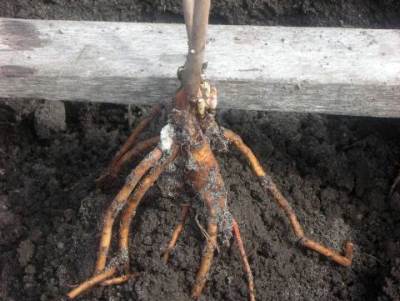
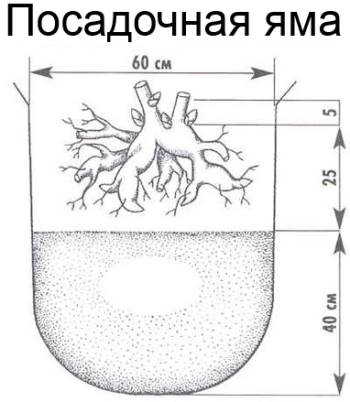
Since the peony has an extensive rhizome with many stems, the gardener can choose the one suitable for planting. You need to choose young ones (they are painted light, in some places White color) with a pair of shoots and several buds located on the roots. The selected parts must be carefully cut with a knife. Places, breaks and cuts should be immediately treated with wood ash or a solution of potassium permanganate.
The pit is filled with garden soil, well-tamped and watered abundantly (however, it is important to ensure that the peony roots are not flooded).
Video:
Features of care
In order for the peony to grow quickly, it is important to ensure that the buds are covered with at least five centimeters of earth. If the peony is on heavy soil, then the layer of earth should be no more than four centimeters. This should be monitored throughout the life of the plant - its successful wintering and abundant flowering depend on it.
The transplanted plant should be watered regularly, in a volume that will give the peony a sufficient amount of nutrients, but at the same time will not destroy its root system. It is important to protect the root part of the bush from frost. In this case, mulch is perfect.
Since the plants buried in the ground are below the young roots, it is recommended to feed and fertilize the plant - best of all with watering.
Immediately after transplanting peonies in the fall to another place, it is recommended to start preparing the plant for winter. Toward the end of October, all shoots need to be cut off at the root and carefully loosen the soil, after watering it well. Since autumn is a rather rainy season, there is no need to water the plant. If the weather is warm, dry outside, the plant still needs to be watered.
Pruning a bush in spring
In the first spring of a peony in a new place, it is recommended to cut off all the flowers - the bush has not yet grown stronger in a new place, if you get rid of all the buds, all the nutrients received by the plant will go to the formation and development of the roots, so that next year the flowering will last longer, and they themselves buds will be larger.
 Undoubtedly, a peony is a very capricious plant, which is why, once in a new place, it may refuse to bloom. In order to cope with this problem and begin to admire the indescribable beauty of the flower again, it is necessary to find the source of this behavior.
Undoubtedly, a peony is a very capricious plant, which is why, once in a new place, it may refuse to bloom. In order to cope with this problem and begin to admire the indescribable beauty of the flower again, it is necessary to find the source of this behavior.
As mentioned above, the peony bush is very picky about lighting. If the gardener is not completely sure whether the flower will be comfortable in a new place, it is better not to risk it.
The first year in a new place is the most difficult for a flower. That is why, in order to help the flower settle in and grow faster, it is recommended to fertilize the plant abundantly. It is not necessary to buy expensive products - ordinary manure is also suitable (it is necessary to water the plant with a rotted solution).
One of the most common causes of peony failure to bloom is the wrong planting level. If the plant is too buried in the ground, it is worth digging it up and planting it correctly; hilling will help with the opposite problem.
Provision of mineral components and fertilizers
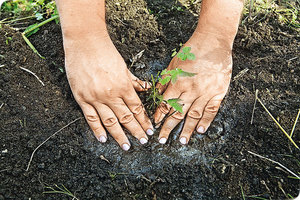 The lack of food is the most obvious reason for the lack of flowering of a flower. In the first year, when the root system of the plant has not yet grown strong, and the peony itself has not had time to adapt to a new place, it is important to give it a sufficient amount of top dressing - with its help, the plant will quickly get used to a new place, grow roots and adapt.
The lack of food is the most obvious reason for the lack of flowering of a flower. In the first year, when the root system of the plant has not yet grown strong, and the peony itself has not had time to adapt to a new place, it is important to give it a sufficient amount of top dressing - with its help, the plant will quickly get used to a new place, grow roots and adapt.
The timing of transplanting peonies in the fall to another place is also important.
Caring for any plant is based on the use of high-quality mineral fertilizers and humus. That is, you need to be able to create the right set of components that can really help peonies. Humus is laid down during the planting period at a shallow depth, or mixed with the soil. Mineral fertilizers are applied already in spring or summer, depending on the condition of the flower.
Incorrect and untimely pruning of leaves can also cause the peony not to show off with its buds. When cutting buds (it does not matter how many years the plant grows in one place), it is absolutely impossible to cut the leaves from the stem. In the first year of flowering, you can leave the bush without all the buds; in subsequent years, it is recommended to cut off no more than a third. The leafy part of the plant is not recommended to be cut before the first frost.
Pest protection
One of the most common peony diseases is rust. Small bugs attack peony buds, sucking juice out of them, thereby depriving the gardener of flowering.
At the end of autumn, during the onset of frost, the stems of peonies should be cut to the very ground, the stems removed and the soil should be watered abundantly. Transplanting roses to another place in the fall in the Moscow region does not differ from other regions. Follow the instructions clearly and you will achieve maximum results.
If the peony is already many years old, and it seems hopeless, do not despair. You can correct the situation by transplanting it to a new place in the fall. After it, the likelihood that the plant will bloom again is very high.
When to transplant peonies - a cheat sheet for success for a grower! Transplanting peonies in the fall - terms and rules Peonies are transplanted for several reasons - the plant has stopped blooming or the color is crushed, you want to increase the number of flowers you love, or for some reason you urgently need to change the place of residence of the bush. When to transplant peonies is the gardener's choice, but it is best to move in August-October: the bush has already faded, the heat has subsided, and the autumn rains are still far away. The flower will have time to adapt to a new place of residence before winter, and by the time of growth and vegetation, the roots will get stronger, and all the energy of the large flower will be directed to growth. Why before the rainy season? So that the cut roots do not absorb a lot of moisture and simply do not rot. For different regions, the timing of transplantation is different: transplantation of peonies in the fall in the Moscow region, in the North-West and in middle lane starts from August 20, lasts until September 25 Ukraine and southern Russia - from September 1 to September 30, in dry weather, peony transplantation in the fall can be extended until October Siberia and the Urals - from August 20 to September 20 In principle, the operation for transplanting peonies after flowering, can be produced at any time of the year, but it is better in autumn so that the plant has time to adapt for the winter after moving - this the best option . In any case, the process begins with choosing a site and digging a hole. The future location of the flower garden should not be in the shade, because flowers love light, located away from the walls that block the sun and screen the heat on the flower beds. Is it possible to transplant peonies in the spring? Peonies - flowers that can grow in one place up to 50 years, these large flowers do not like frequent transplants, especially in spring. Experienced gardeners strongly recommend making any manipulations for moving in the fall, with the exception of transplanting peonies by transshipping a bush (young) with a clod of earth. But, the circumstances are different. When transplanting peonies in the spring, the rule applies - the sooner the better. Therefore, the process should begin as soon as the snow melts. Soil flooding with melted snow can also be a good reason to change the location of the bush. Planting begins before the start of the growing season, otherwise it is easy to disrupt the root system during transplantation. Peonies transplanted from one place to another in the spring are stunted. With proper planting and proper care, the survival rate of the plant is quite high. place Bush transplant rules Grown bushes will need a lot of space, it is advisable to dig holes for planting at a distance of 1-1.5 meters. Since it is necessary to plant peonies to a depth of no more than 5-8 cm (more - the bush will sprout for a long time, less - it will freeze in winter), a large hole is not required: 15 cm in depth is enough, 40 in diameter. Fertilizer is placed at the bottom of the prepared pit - humus, manure, other organic matter. To give looseness, you can add sand, if the soil is sufficiently ventilated, this step will be superfluous. Transfer the divided and disinfected bush and dig in, forming a hill 10 cm high. Water the bush abundantly, if desired, mulch the plant with peat or humus. To transplant peonies in autumn to another place, it is necessary to cut the bushes, leaving about 20 cm of branches and dig them in a radius of 20 cm. In order not to damage the rhizomes of pions during transplantation, it is better to dig a flower with a pitchfork. Dig the bush so that the root system easily comes out of the ground. The roots are washed, cut broken and rotten, treated with a weak solution of potassium permanganate. To make the root system more elastic, it is recommended to put the plant in the shade for a couple of hours. The weathered root is not so fragile. Now you can start moving. It is worth noting that the transplant does not depend on which varieties of peonies you want to move on the site, with the exception of the tree peony. If the plant is 4 years old and needs to be propagated, it is time to transplant peonies after flowering to separate the roots. After the root system has been removed and cleaned of soil, inspect it. Samples with six or more buds are suitable for separation, since at least 3 buds must be left on the separated cut part. We dry the root, cut it with a disinfected knife, treat it with a light solution of manganese and proceed to planting. By spring, large flowers will get stronger and can please with flowers. Knowledgeable gardeners recommend cutting off the first color so that the plant takes root better, and in the second year - enjoy abundant flowering. Helpful tips for transplanting large flowers Peonies are beautiful flowers that do not require special care, but proper planting will help the plant recover faster and begin to bloom. Experienced flower growers recommend adhering to a few simple rules: During spring transplantation, the air temperature outside should reach +10 ° C, and the earth should warm up to +3 ° C - it is at this temperature that the growth and formation of the roots of the bush begins Flowers are unpretentious to the soil - in soil with sand the bush will bloom faster, but quickly lose its decorative effect, in clay soil appearance peony will please longer, but flowering will come with a delay After transplantation, the plant requires careful attention to itself for a year until it gets stronger When choosing a new site, pay attention to bright, draft-protected places - shade can stop flowering Avoid abundant watering, especially after dividing roots - the bush quickly gains moisture, it can rot. For the same reason, when choosing a place, pay attention that melt and rain water does not flow to the bushes. During transplantation, be sure to feed the plant, make drainage in the pit. In a new place, with proper care, the bush blooms for 2- 3 years old If there is no flowering, there may be little moisture and nutrients in the soil. To correct the situation, feed the flower. It can be caused by an incorrect planting depth or poor shelter of the bush for the winter, lack of light on the site. The situation can be corrected with an additional transplant. When to transplant peonies? The choice depends on the desire of the gardener and the circumstances. Follow these simple guidelines to get the lush color of this unpretentious perennial shrub.
Not many novice gardeners know when to transplant peonies, when to do it. It is better to move a flower from one place to another without disturbing the root system, unless, of course, this is a division of the bush. Root separation and transshipment in spring and autumn is done according to the rules, so carefully read the step-by-step guide to minimize injury to your beautiful plants ...

Transplanting peonies in the fall - terms and rules
Peonies are transplanted for several reasons - the plant has stopped blooming or the color is crushed, you want to increase the number of flowers you love, or for some reason you urgently need to change the place of residence of the bush. When to transplant peonies is the gardener's choice, but it is best to move in August-October: the bush has already faded, the heat has subsided, and the autumn rains are still far away. The flower will have time to adapt to a new place of residence before winter, and by the time of growth and vegetation, the roots will get stronger, and all the energy of the large flower will be directed to growth.
Why before the rainy season? So that the cut roots do not absorb a lot of moisture and simply do not rot. For different regions, the timing of transplantation is different:
- transplantation of peonies in the fall in the Moscow region, in the North-West and in the Middle lane begins on August 20, continues until September 25
- Ukraine and the south of Russia - from September 1 to September 30, in dry weather, pion transplantation in autumn can be extended until October
- Siberia and the Urals - from August 20 to September 20
In principle, the operation for transplanting peonies after flowering can be performed at any time of the year, but it is better in the fall, so that the plant has time to adapt for the winter after moving - this is the best option. In any case, the process begins with choosing a site and digging a hole. The future location of the flower garden should not be in the shade, because flowers love light, located away from the walls that block the sun and screen the heat on the flower beds.
Is it possible to transplant peonies in the spring?
Peonies - flowers that can grow in one place up to 50 years, these large flowers do not like frequent transplants, especially in spring. Experienced gardeners strongly recommend making any manipulations for moving in the fall, with the exception of transplanting peonies by transshipping a bush (young) with a clod of earth. But, the circumstances are different.
When transplanting peonies in the spring, the rule applies - the sooner the better. Therefore, the process should begin as soon as the snow melts. Soil flooding with melted snow can also be a good reason to change the location of the bush.
- Planting begins before the start of the growing season, otherwise it is easy to disturb the root system during transplantation
- Peonies transplanted from one place to another in the spring are stunted
- With proper planting and proper care, the survival rate of the plant is quite high.
- It is categorically not recommended to divide peonies in spring, only move large flowers to another place
Bush transplant rules
The grown bushes will need a lot of space, it is advisable to dig holes for planting at a distance of 1-1.5 meters. Since it is necessary to plant peonies to a depth of no more than 5-8 cm (more - the bush will sprout for a long time, less - it will freeze in winter), a large hole is not required: 15 cm in depth is enough, 40 in diameter. Fertilizer is placed at the bottom of the prepared pit - humus, manure, other organic matter. To give looseness, you can add sand, if the soil is sufficiently ventilated, this step will be superfluous. Transfer the divided and disinfected bush and dig in, forming a hill 10 cm high. Water the bush abundantly, if desired, mulch the plant with peat or humus.
To transplant peonies in autumn to another place, it is necessary to cut the bushes, leaving about 20 cm of branches and dig them in a radius of 20 cm. In order not to damage the rhizomes of pions during transplantation, it is better to dig a flower with a pitchfork. Dig the bush so that the root system easily comes out of the ground. The roots are washed, cut broken and rotten, treated with a weak solution of potassium permanganate. To make the root system more elastic, it is recommended to put the plant in the shade for a couple of hours. The weathered root is not so fragile. Now you can start moving. It is worth noting that the transplant does not depend on which varieties of peonies you want to move on the site, the exception is.
If the plant is 4 years old and needs to be propagated, it is time to transplant peonies after flowering to separate the roots. After the root system has been removed and cleaned of soil, inspect it. Samples with six or more buds are suitable for separation, since at least 3 buds must be left on the separated cut part. We dry the root, cut it with a disinfected knife, treat it with a light solution of manganese and proceed to planting. By spring, large flowers will get stronger and can please with flowers. Knowledgeable gardeners recommend cutting off the first color so that the plant takes root better, and in the second year - enjoy abundant flowering.
Peonies are beautiful flowers that do not require special care, but proper planting will help the plant get sick faster and begin to bloom. Experienced flower growers recommend following a few simple rules:
- During spring transplantation, the air temperature outside should reach +10 ° C, and the earth should warm up to +3 ° C - it is at this temperature that the growth and formation of the roots of the bush begins
- Flowers are unpretentious to the soil - in soil with sand, the bush will bloom faster, but will quickly lose its decorative effect, in clay soil the appearance of the peony will please longer, but flowering will come with a delay
- After transplantation, the plant requires careful attention to itself for a year, until it gets stronger.
- When choosing a new site, pay attention to light, draft-protected places - shade can stop flowering
- Avoid abundant watering, especially after dividing the roots - the bush quickly gains moisture, it can rot
- For the same reason, when choosing a place, pay attention that melt and rain water does not flow to the bushes.
- During transplantation, be sure to feed the plant, make drainage in the pit
In a new place, with proper care, the bush blooms for 2-3 years. If there is no flowering, there may be little moisture and nutrients in the soil. To correct the situation, feed the flower. It can be caused by an incorrect planting depth or poor shelter of the bush for the winter, lack of light on the site. The situation can be corrected with an additional transplant.
When to transplant peonies? The choice depends on the desire of the gardener and the circumstances. Follow these simple guidelines to get the lush color of this unpretentious perennial shrub.
If a large peony is simply dug up and transplanted to another place, then the next year it forms many small shoots and. Therefore, before transplanting a large bush, it should be rejuvenated: divided into smaller parts of the division.
If you need to transplant or divide peonies, then the most favorable time for this is the end of August and all of September. During this period, the formed buds of renewal are already clearly visible on the rhizomes of the bushes, but the formation of small annual (suction) roots that supply the plant with water and nutrients has not yet begun. Take a close look at the peony. Each cluster of kidneys has its own roots. It is best to divide the bush into such pieces.
The standard division of a peony is a piece of rhizome with 1-3 shortened roots and 2-5 renewal buds. Too small segments will not bloom for a long time, and large ones (with 6 or more buds) due to old roots can please flowering in the first year. But due to the fact that they did not grow new roots, flowering may then weaken. New buds, leaves and flowers in a peony always appear from the root neck (upper part of the root). And the roots themselves, gradually taking root and spreading to the sides, become the storage nutrients of the rhizome.
Before transplanting peonies in August or September, the old stems are cut at a height of 5-7 cm. The peony is taken out, prying the roots from below. It is not worth holding it by the stems, so as not to break the kidneys sitting on them. But the thick roots that go deep into the soil can not be particularly regretted and, when digging, cut off everything that is deeper than 15-20 cm. 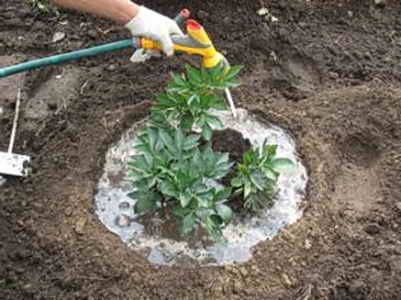
Freshly dug roots break easily, therefore, having cleaned and washed them from the soil, they allow the rhizome to wilt slightly in the shade (it will take 5-6 hours, but you can wait 1-2 days) and only then begin to divide.
In places where the roots easily disintegrate, they are separated by hand. Old and rough parts are cut off with a knife or cut off with a shovel. Very large specimens are divided using a wooden pointed stake hammered into the center of the rhizome. Gently rocking it, first separate large pieces. Then they share more easily.
As a result, on a delenka, for each well-ripened bud, there should be at least 10 cm of light young or old shortened roots.
A pit for transplanting peonies in August is prepared in advance. The optimal depth and diameter is 60 × 70 cm. It is 3/4 filled with a nutrient mixture: 0.5 cups of superphosphate and potassium chloride are added to 2 buckets of humus. On acidic soils, add another 2 cups of lime or ash. Everything is well mixed, watered and left for a while.
When planting in a pit, sprinkle garden soil without fertilizers (you can take it from the beds). The rhizome of the peony is positioned so that the uppermost bud is at ground level. The soil is lightly compacted by hand.
For better rooting, delenki can be watered with root (1 g per 1 liter of water), and then mulched with humus.
The main principles of planting ornamental shrubs and their propagation
Digging rules and storage methods for dahlias
How to grow brugmansia
How to make a rose hedge
The black root plant saves the garden from mice